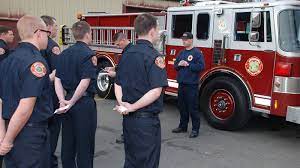Are you interested in a career as a firefighter? If so, then you should be prepared to invest in your training and work hard to develop the skills necessary for success. A firefighter training program is an excellent way to get started in this rewarding career field.
In this article, we’ll discuss the steps you should take to prepare for firefighting and the fire service. We’ll also explore the myths of fire safety and what fire safety clothing is recommended.
What are the steps you should take to get ready for fire service?
The fire service is a physically and mentally demanding job, so physical fitness should be at the top of your list. You’ll need to stay in shape, maintain strength and cardiovascular endurance, practice fire safety drills regularly, and keep up with fire science courses.
You will also want to brush up on firefighting techniques such as fire suppression systems, fire attack, fire containment, and fire prevention. These techniques can be learned through practice drills and fire service courses.
Additionally, it is important to become familiar with the job duties of a firefighter. Learning about fire apparatus and its operation, building construction, hazardous materials control, search and rescue, and medical emergencies are all important components of the job that you should understand before entering the fire service.
Finally, you should also become familiar with the myths of fire safety. For example, fires can spread quickly if combustible items are left in direct contact with a flame source. It is important to understand that proper smoke detectors and sprinklers can help slow down the spread of a fire as well as recognize and respond to potential hazards before they become a problem.
What are some of the myths about working in the fire service?
Working in the fire service is a dangerous job and there are several myths about it. Here are some of the common fire safety myths that you should be aware of:
Myth 1: Fire sprinklers are not effective in fire suppression.
Fact: According to the National Fire Protection Association, fire sprinklers are highly effective in fire suppression. This fire safety tool has been proven to reduce fire deaths by up to 80%.
Myth 2: Fires aren’t dangerous if you stick around long enough.
Fact: The truth is that fires spread quickly, so staying in a burning building can be extremely risky. The best thing to do is evacuate the area as soon as possible. You should also be aware of fire safety clothing like fire-retardant suits that can help protect you from fire and smoke exposure.
Myth 3: Smoke detectors are not necessary for all buildings.
Fact: Smoke detectors should be installed in every building, regardless of size or occupancy. These devices will detect both smoke and fire, giving you a warning before fire and smoke can spread.
Myth 4: Fire extinguishers are only for fire suppression.
Fact: Fire extinguishers should not be used to fight a fire, but instead as a way of controlling and containing the fire until first responders arrive on the scene. So when an extinguisher is used, fire suppression should not be delayed.
These are just a few of the fire safety myths that you should be aware of. When you are preparing for a fire service career, it is important to educate yourself about fire safety and be aware of the myths surrounding firefighting.
What are the fire safety gears needed for firefighting?
Fire safety clothing is an important part of firefighting. Suits and helmets are the most common fire safety gear, but other items such as gloves, boots, fire hoods, and breathing apparatus may also be needed depending on the situation. It is important to know what fire safety clothing is necessary to remain safe in firefighting situations.
Overall, firefighting is an important and rewarding job. By following the tips outlined above and staying up to date on fire safety myths, you can ensure that you are prepared for this career field. Be sure to have the right fire safety clothing and knowledge to stay safe while firefighting.
Do you have any other comments or questions? Please leave them in the comments section. We are happy to answer any queries you may have.


















